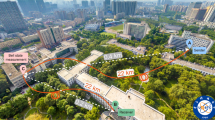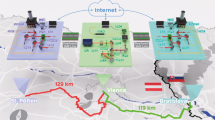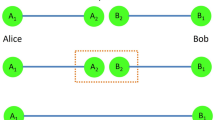A real-world experiment marks a step towards worldwide quantum communication.
Abstract
Efficient long-distance quantum teleportation1 is crucial for quantum communication and quantum networking schemes2. Here we describe the high-fidelity teleportation of photons over a distance of 600 metres across the River Danube in Vienna, with the optimal efficiency that can be achieved using linear optics. Our result is a step towards the implementation of a quantum repeater3, which will enable pure entanglement to be shared between distant parties in a public environment and eventually on a worldwide scale.
Similar content being viewed by others
Main
Quantum teleportation is based on a quantum channel, here established through a pair of polarization-entangled photons shared between Alice and Bob (Fig. 1). We have implemented this by using an 800-metre-long optical fibre installed in a public sewer system located in a tunnel underneath the River Danube, where it is exposed to temperature fluctuations and other environmental factors.
The quantum channel (fibre F) rests in a sewage-pipe tunnel below the river in Vienna, while the classical microwave channel passes above it. A pulsed laser (wavelength, 394 nm; rate, 76 MHz) is used to pump a β-barium borate (BBO) crystal that generates the entangled photon pair c and d and photons a and b (wavelength, 788 nm) by spontaneous parametric down-conversion. The state of photon b after passage through polarizer P is the teleportation input; a serves as the trigger. Photons b and c are guided into a single-mode optical-fibre beam splitter (BS) connected to polarizing beam splitters (PBS) for Bell-state measurement. Polarization rotation in the fibres is corrected by polarization controllers (PC) before each run of measurements. The logic electronics identify the Bell state as either |ψ−〉bc or |ψ+〉bc and convey the result through the microwave channel (RF unit) to Bob's electro-optic modulator (EOM) to transform photon d into the input state of photon b.
For Alice to be able to transfer the unknown polarization state of an input photon |χ〉b, she has to perform a joint Bell-state measurement on the input photon b and her member, c, of the shared entangled photon pair (c and d). Our scheme allows her to identify two of the four Bell states, the optimum achievable with only linear optics4,5.
As a result of this Bell-state measurement, Bob's ‘receiver’ photon d will be projected into a well defined state that already contains full information on the original input photon b, except for a rotation that depends on the specific Bell state that Alice observed. Our teleportation scheme therefore also includes active feed-forward of Alice's measurement results, which is achieved by means of a classical microwave channel together with a fast electro-optical modulator (EOM). It enables Bob to perform the unitary transformation on photon d to obtain an exact replica of Alice's input photon b.
Specifically, if Alice observes the |ψ−〉bc Bell state, which is the same as the initial entangled state of photons c and d, then Bob already possesses the original input state. But if Alice observes the |ψ+〉bc state, he introduces a π-phase shift between the horizontal and vertical polarization components of photon d by applying a voltage pulse of 3.7 kV on the EOM. For successful operation, Bob has to set the EOM correctly before photon d arrives. Because of the reduced velocity of light within the fibre-based quantum channel (two-thirds of that in vacuo), the classical signal arrives about 1.5 microseconds before the photon.
We demonstrated the teleportation of three distinct polarization states: linear at 45°, left-handed circular or horizontal. The teleportation fidelity achieved was 0.84, 0.86 or 0.90 for the 45°, for each of these input states, respectively. These fidelities comfortably surpass the classical limit of 0.66 (ref. 6) and prove that our teleportation system is operating correctly. Without operation of the EOM, however, Bob observes a completely mixed polarization for the 45° and circular polarization input states, causing the observed fidelity for these states to drop to 0.54 and 0.59, respectively, in the absence of active unitary transformation. The deviation from the random fidelity of 0.5 is due to statistical fluctuations in the observed counts.
Each measurement run lasted for 28 h and the rate of successful teleportation events was 0.04 per second. Polarization stability proved to be better than 10° on the fibre between Alice's and Bob's labs, corresponding to an ideal teleportation fidelity of 0.97 over a full measurement run. Hence, despite the exposure of our system to the environment, high-fidelity teleportation was still achievable without permanent readjustments.
We have demonstrated quantum teleportation over a long distance and with high fidelity under real-world conditions outside a laboratory. Our system combines for the first time, to our knowledge, an improved Bell-state analyser with active unitary transformation, enabling a doubling of the efficiency of teleportation compared with earlier experiments based on independent photons7,8. Our experiment demonstrates feed-forward of measurement results, which will be essential for linear-optics quantum computing9,10,11, and constitutes a step towards the full-scale implementation of a quantum repeater.
References
Bennett, C. H. et al. Phys. Rev. Lett. 70, 1895–1899 (1993).
Bose, S., Vedral, V. & Knight, P. L. Phys. Rev. A 57, 822–829 (1998).
Briegel, H. J., Dür, W., Cirac, J. I. & Zoller, P. Phys Rev. Lett. 81, 5932–5935 (1998).
Lütkenhaus, N., Calsamiglia, J. & Suominen, K. -A. Phys. Rev. A 59, 3295–3300 (1999).
Kim, Y. -H. et al. Phys. Rev. Lett. 86, 1370–1373 (2001).
Popescu, S. Phys. Rev. Lett. 72, 797–799 (1994).
Bouwmeester, D. et al. Nature 390, 575–579 (1997).
Marcikic, I., de Riedmatten, H., Tittel, W., Zbinden, H. & Gisin, N. Nature 421, 509–513 (2003).
Riebe, M. et al. Nature 429, 734–737 (2004).
Barrett, M. D. et al. Nature 429, 737–739 (2004).
Gottesmann, D. & Chuang, I. L. Nature 402, 390–393 (1999).
Author information
Authors and Affiliations
Corresponding author
Ethics declarations
Competing interests
The authors declare no competing financial interests.
Rights and permissions
About this article
Cite this article
Ursin, R., Jennewein, T., Aspelmeyer, M. et al. Quantum teleportation across the Danube. Nature 430, 849 (2004). https://doi.org/10.1038/430849a
Published:
Issue Date:
DOI: https://doi.org/10.1038/430849a
This article is cited by
-
Cyclic Quantum Teleportation with Multi-Level of Control
International Journal of Theoretical Physics (2024)
-
Demonstration of controlled high-dimensional quantum teleportation
Science China Physics, Mechanics & Astronomy (2024)
-
Hertz-rate metropolitan quantum teleportation
Light: Science & Applications (2023)
-
Quantum Teleportation of the Entangled Superconducting Qubits via LC Resonators
International Journal of Theoretical Physics (2023)
-
Complete and fidelity-robust hyperentangled-state analysis of photon systems with single-sided quantum-dot-cavity systems under the balance condition
Quantum Information Processing (2023)
Comments
By submitting a comment you agree to abide by our Terms and Community Guidelines. If you find something abusive or that does not comply with our terms or guidelines please flag it as inappropriate.




